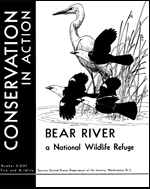United States Fish and Wildlife Service

United States Fish and Wildlife Service: Publications
Date of this Version
7-23-2010
Citation
U.S. Fish and Wildlife Service. 2010. Waterfowl population status, 2010. U.S. Department of the Interior, Washington, D.C. USA.
Abstract
In the traditional survey area, which includes strata 1‒18, 20‒50, and 75‒77, the total duck population estimate was 40.9 ± 0.7 [SE] million birds. This estimate was similar to last year's estimate of 42.0 ± 0.7 million birds and was 21% above the long-term average (1955‒2009). Estimated mallard (Anas platyrhynchos) abundance was 8.4 ± 0.3 million birds, which was similar to the 2009 estimate of 8.5 ± 0.2 million birds and 12% above the long-term average. Estimated abundance of gadwall (A. strepera; 3.0 ± 0.2 million) was similar to the 2009 estimate and 67% above the long-term average. Estimated abundance of American wigeon (A. americana; 2.4 ± 0.1 million) was similar to 2009 and the long-term average. The estimated abundance of green-winged teal (A. crecca) was 3.5 ± 0.2 million, which was similar to the 2009 estimate and 78% above their longterm average of 1.9 ± 0.02 million. The estimate of blue-winged teal abundance (A. discors) was 6.3 ± 0.4 million, which was 14% below the 2009 estimate and 36% above their long-term average of 4.7 ± 0.04 million. The estimate for northern pintails (A. acuta; 3.5 ± 0.2 million) was similar to the 2009 estimate, and 13% below the long-term average of 4.0 ± 0.04 million. Estimates of northern shovelers (A. clypeata; 4.1 ± 0.2 million) and redheads (Aythya americana; 1.1 ± 0.1 million) were similar to their 2009 estimates and were 76% and 63% above their long-term averages of 2.3 ± 0.02 million and 0.7 ± 0.01 million, respectively. The canvasback estimate (A. valisineria; 0.6 ± 0.05 million) was similar to the 2009 estimate and to the long-term average. The scaup estimate (A. affinis and A. marila combined; 4.2 ± 0.2 million) was similar to that of 2009 and 16% below the long-term average of 5.1 ± 0.05 million. Habitat conditions during the 2010 Waterfowl Breeding Population and Habitat Survey were characterized by average to below-average moisture, a mild winter, and early spring across the traditional and eastern survey areas. The total pond estimate (Prairie Canada and U.S. combined) was 6.7 ± 0.2 million. This was similar to the 2009 estimate and 34% above the long-term average (1974‒2009) of 5.0 ± 0.03 million ponds. The 2010 estimate of ponds in Prairie Canada was 3.7 ± 0.2 million. This was similar to last year's estimate (3.6 ± 0.1 million) and to the long-term average (1961‒2009; 3.4 ± 0.03 million). The 2010 pond estimate for the north central U.S. was 2.9 ± 0.1 million, which was similar to last year's estimate (2.9 ± 0.1 million) and 87% above the long-term average (1974‒2009; 1.6 ± 0.02 million). The projected mallard fall-flight index is 10.3 ± 0.9 million birds. The eastern survey area was restratifed in 2005 and is now composed of strata 51‒72. Estimates of mallards, scaup, scoters (black [Melanitta nigra], white-winged [M. fusca], and surf [M. perspicillata]), green-winged teal, American wigeon, bufflehead (Bucephala albeola), ring-necked duck (Aythya collaris), and goldeneyes (common [B. clangula] and Barrow's [B. islandica]) were all similar to their 2009 estimates and long-term averages. The merganser (red-breasted [Mergus serrator], common [M. merganser], and hooded [Lophodytes cucullatus]) estimate was 386.4 thousand, which was 15% below the 2009 estimate, and 14% below the long-term average of 450.8 thousand. The American black duck (Anas rubripes) estimate was similar to the 2009 estimate and 7% below the long-term average of 478.9 thousand.

